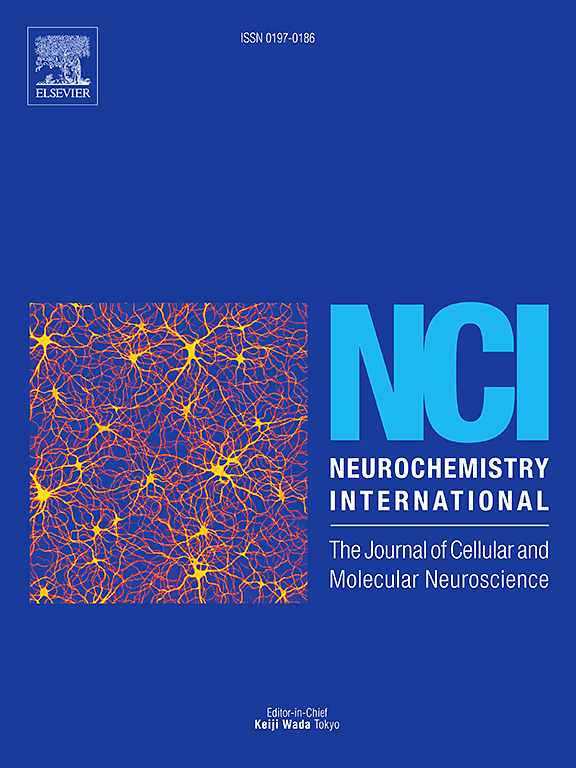Thiamet-G ameliorates Parkinson's disease-associated cognitive impairment via increasing O-GlcNAcylation of STING in the microglia
IF 4
3区 医学
Q2 BIOCHEMISTRY & MOLECULAR BIOLOGY
引用次数: 0
Abstract
Microglia activation contributed to the development of Parkinson's disease (PD)-associated cognitive impairment and targeting microglia may be a promising strategy for improving the cognitive function in PD. O-GlcNAclytion is a novel protein post-translational modification with cognitive enhancing effects. This study aimed to investigate the effects of Thiamet-G (TMG), an O-GlcNAcase inhibitor that can increase the intracellular O-GlcNAclytion levels, on PD-associated cognitive impairment and the mechanism related to microglia activation. A PD mouse model was established using rotenone (ROT) and the cognitive functions of these mice were investigated by behavioral tests. The anti-inflammatory effects of TMG were tested in the BV2 microglia cells. TMG treatment significantly improved the cognitive function in the ROT-induced PD mouse model as evidenced by the Y-maze test and objective recognition test. Histological studies showed that TMG decreased the reactive microglia via increasing the total protein O-GlcNAclytion levels in the hippocampus of the PD mice. In the in vitro studies, TMG inhibited ROT-induced inflammation via decreasing the pro-inflammatory cytokines such as TNF-α, IL-1β and IL-6 in BV2 microglia cells. Bioinformatic analysis revealed that STING, a core protein in the innate immunity regulation, might be a novel target of O-GlcNAclytion. The immunoprecipitation experiments further confirmed that TMG inhibited STING phosphorylation via increasing O-GlcNAcylation. Taken together, TMG might ameliorate PD-associated cognitive impairment via increasing O-GlcNAcylation of STING in microglia, which provided evidence supporting that inhibiting the inflammatory response of microglia by elevating the O-GlcNAclytion levels might be an effective strategy for improving the cognitive function in PD.
Thiamet-G通过增加小胶质细胞中STING的o - glcn酰化来改善帕金森病相关的认知障碍
小胶质细胞的激活有助于帕金森病(PD)相关认知功能障碍的发展,靶向小胶质细胞可能是改善PD认知功能的一种有希望的策略。o - glcnaclyation是一种具有认知增强作用的新型蛋白质翻译后修饰。本研究旨在探讨Thiamet-G (TMG)是一种O-GlcNAcase抑制剂,可提高细胞内O-GlcNAcase水平,对pd相关认知障碍的影响及其与小胶质细胞活化的相关机制。采用鱼藤酮(rotenone, ROT)建立PD小鼠模型,通过行为学测试观察小鼠的认知功能。在BV2小胶质细胞中检测TMG的抗炎作用。经y迷宫实验和客观识别实验证实,TMG治疗可显著改善rot诱导的PD小鼠模型的认知功能。组织学研究表明,TMG通过增加PD小鼠海马总蛋白o - glcnaclyation水平来降低反应性小胶质细胞。在体外研究中,TMG通过降低BV2小胶质细胞中促炎细胞因子TNF-α、IL-1β和IL-6来抑制rot诱导的炎症。生物信息学分析表明,作为先天免疫调控的核心蛋白,STING可能是o - glcnaclyation的新靶点。免疫沉淀实验进一步证实TMG通过增加o - glcnac酰化抑制STING磷酸化。综上所述,TMG可能通过增加小胶质细胞中STING的o - glcn酰化来改善PD相关的认知功能障碍,这为通过提高o - glcn酰化水平来抑制小胶质细胞的炎症反应可能是改善PD认知功能的有效策略提供了证据。
本文章由计算机程序翻译,如有差异,请以英文原文为准。
求助全文
约1分钟内获得全文
求助全文
来源期刊

Neurochemistry international
医学-神经科学
CiteScore
8.40
自引率
2.40%
发文量
128
审稿时长
37 days
期刊介绍:
Neurochemistry International is devoted to the rapid publication of outstanding original articles and timely reviews in neurochemistry. Manuscripts on a broad range of topics will be considered, including molecular and cellular neurochemistry, neuropharmacology and genetic aspects of CNS function, neuroimmunology, metabolism as well as the neurochemistry of neurological and psychiatric disorders of the CNS.
 求助内容:
求助内容: 应助结果提醒方式:
应助结果提醒方式:


